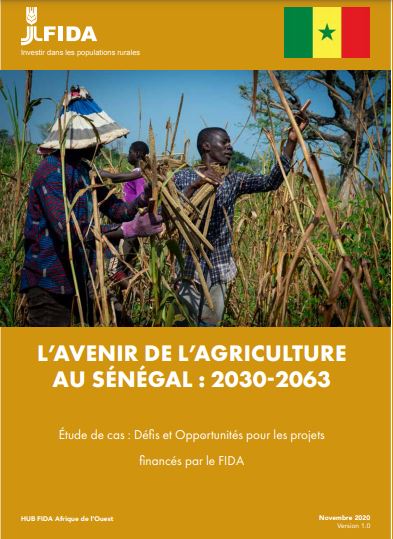The future of agriculture in Senegal: 2030 – 2063

ABSTRACT
In future decades, Senegal will face challenges to ensure its food security and improve the income of its rapidly expanding and urbanizing population. It will not only be a question of producing more for more people despite the threat of climate change on yields and their regularity, but also of producing better (in terms of quality and diversity of products) while preserving natural resources. Agricultural and non-agricultural incomes will have to increase and ensure food security, a major component of lifting vulnerable populations out of poverty.
The outlook for agriculture is set against several major trends that are shaping the development of the sector. Among them are rapid population growth, urbanization, income growth, rural emigration, strengthened links between rural and urban areas and the integration of sectors and economic actors. These trends, lead to an integrated food policy made up of increasingly numerous and complex agri-food value chains, conducive to the creation of employment.
The importance of the agricultural sector for food security is reflected in the “Programme d’Accélération de la Cadence de l’Agriculture Sénégalaise-PRACAS” in which the needs to strengthen agricultural potential and to diversify horizontal and vertical production/ export profiles are designed. The decline of controlled products such as groundnuts and fishing has forced the country to shift from traditional agriculture to more commercial agriculture. Non-traditional sectors such as fruit and vegetables have seized incurring business opportunities at the national, regional and international levels. These products are emerging as new profitable export channels. Producer and exporter organizations have proven their driving capacity by adapting their business models to the needs of emerging markets. Vertical diversification, which involves the transformation of local products, represents another growth potential and enjoys growing policy support.
Food needs are expected to increase, especially between 2050 and 2100, and will not be met by production, except for pulses. In order to produce sufficient food, cultivated areas would need to triple, which is not realistic. Another way to achieve these targets would be to increase productivity, which requires heavy investment. It is estimated that current investment levels would need to be multiplied by 20 by 2100. This can only be met through substantial reallocation of public expenditure, external public development aid, as well as by defining a support policy for producers and other national and foreign private actors to increase their investments. Promoting well-targeted investments in agriculture requires a clear strategy that identifies the major agricultural products and their value chains most in need of investment, as well as the investors.
The following priority areas of investment are likely to improve integrated food security in an active agricultural sector: i) control of irrigation water through hydro-agricultural facilities. Senegal is supposed to have 349,000 ha of irrigable land, of which less than a third is developed; ii) promoting technological change and productivity growth suitable to local contexts. Research and development, together with improved extension services generates high rates of return on investment on change in production and processing systems; iii) improvement of the infrastructure for access, storage, processing, marketing of inputs and products, etc. for the enhancement of the agricultural value chains which generate multiplier effects on jobs and the economy as a whole; iv) permanent and regular physical and financial access to suitable agricultural inputs and equipment, through appropriate trade and pricing policies. Subsidies can, in the short term, address failures in infrastructure, credit and input markets, and facilitate introduction of improved inputs. They are nevertheless an obstacle to the development of private input markets and impede resources allocation.
Ultimately, agriculture plays a major role in the structural transformation of rural areas through the following vectors: i) intensive small familial agriculture on sustainable basis and resilient to climate change; ii) the development of agrifood value chains that offer agricultural and non-agricultural employment and income opportunities, and facilitate access to adapted and diversified food systems; iii) strengthening links between rural and urban areas, a link that enables the integration of sectors, actors and services. Because of its effects on income, food security, nutrition and socio-economic benefits, the transformation is of critical interest to the entire rural population.